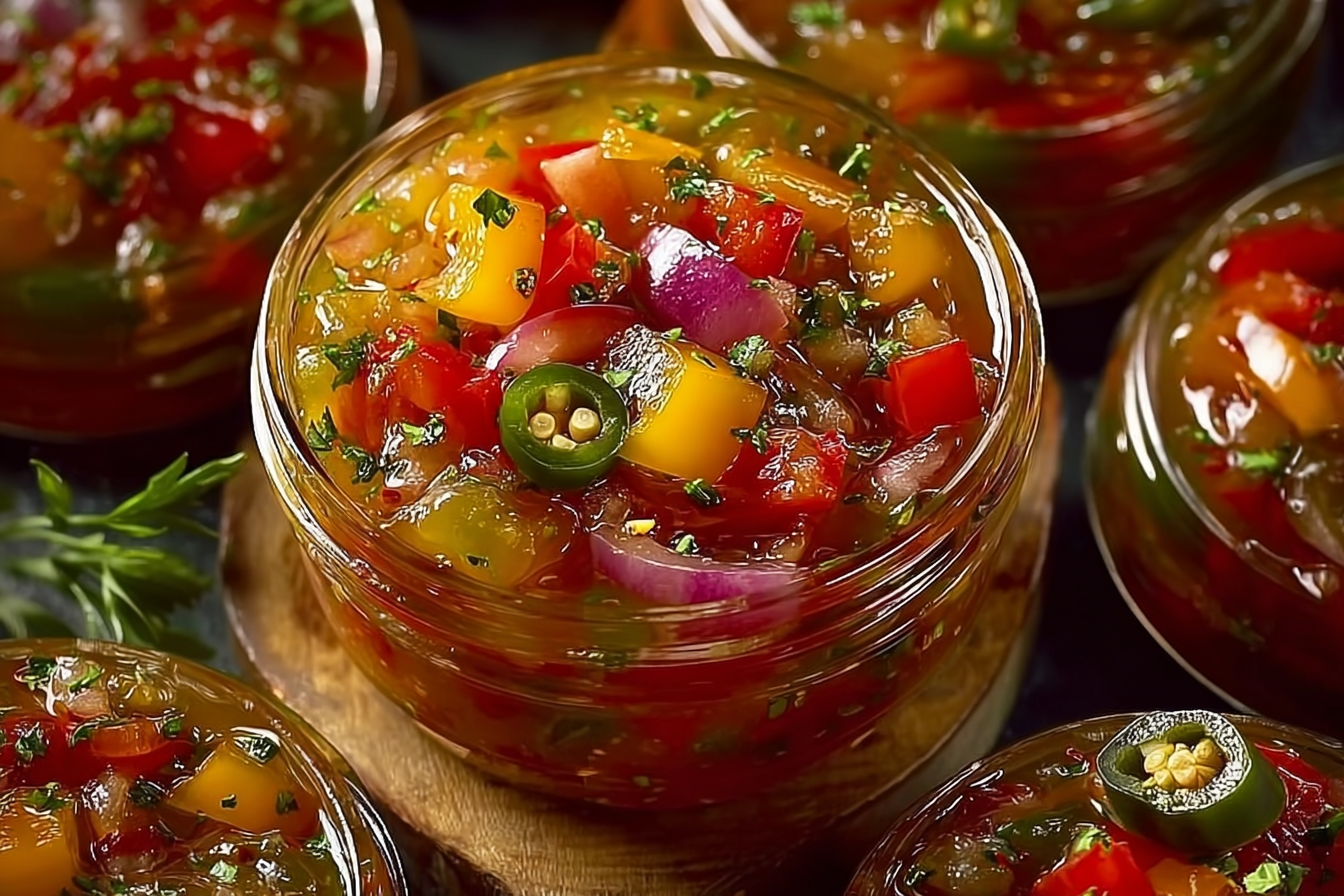Pickled Pepper and Onion Relish Recipe is a nostalgic burst of sweet, tangy flavor that instantly transforms even the simplest meal into something unforgettable. Whether you’re spreading it on a juicy burger, scooping it alongside grilled sausages, or gifting it in mason jars, this homemade relish will be your new secret weapon in the kitchen.
At Cooking Flash, About page ,we don’t just develop recipes—we pass down flavor memories. Our story began with family food traditions built around everyday ingredients and elevated by small, thoughtful touches. This Pickled Pepper and Onion Relish Recipe is one of those special creations born in our kitchen, crafted with love, and refined over time through feedback from readers just like you. What started as a way to use up late-summer vegetables turned into a treasured staple—and now, we’re sharing that joy with you.
Learn more about our Juicy Air Fryer Hamburgers for the perfect pairing to this zingy relish. Ready to stir up a little sweet heat in your kitchen? Let’s dive in.
Table of Contents
Table of Contents
What is Pickled Pepper and Onion Relish?
The Flavor-Packed Condiment You Didn’t Know You Needed
A Pickled Pepper and Onion Relish Recipe isn’t just a pantry filler—it’s a vibrant condiment layered with bright vinegar tang, sweet mellow onions, and juicy peppers that dance with heat or stay sweet, depending on your mood. Unlike plain pickles or basic chutneys, this relish boasts a syrupy consistency and complex flavor that bridges savory and sweet like few others.
Whether you’re using it hot as a topping or cold from the fridge, it blends seamlessly into countless dishes. It’s bold without being overpowering, and that balance is what makes it so addictive.
From Farmstand Roots to Fridge Staple
The roots of onion and pepper relish trace back to American farm kitchens, where preserving end-of-season vegetables was more necessity than hobby. Old-fashioned pickled pepper and onion relish recipes were born out of this spirit—cooked in giant batches and stored in glass jars in cool pantries. Back then, families didn’t waste anything. Today, we celebrate those same values in small-batch preserving with recipes that honor the past and fit modern tastes.
This dish has made a resurgence thanks to DIY food culture and the growing interest in canning and preserving. In fact, many people search for old fashioned pickled pepper and onion relish recipes or easy sweet pepper relish just to connect with that homemade magic.
Modern Touches with Classic Soul
The best part about this recipe? It bridges generations. While it maintains the charm of an old-fashioned onion relish recipe, it adds modern flair—think Ninja Foodi use, spice customization, and fridge-friendly storage.
This version is so approachable that even beginners looking for an easy pickled pepper and onion relish recipe can pull it off on the first try. Whether you want it mild and mellow or punchy and peppery, the adaptability of this dish makes it stand out.
So, whether you’re a beginner or an experienced preserver, this is the best pickled pepper and onion relish recipe to start with. And just wait—we’re only getting started.
Print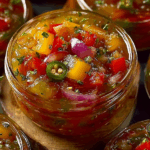
Irresistibly Easy Pickled Pepper and Onion Relish Recipe That Will Elevate Every Bite
- Prep Time: 10 minutes
- Cook Time: 15 minutes
- Total Time: 25 minutes
- Yield: 2 to 2½ cups
- Category: Condiment
- Method: Simmering
- Cuisine: American
- Diet: Vegan
Description
A tangy-sweet pepper and onion relish made with white wine vinegar, sugar, and colorful vegetables—perfect as a topping or side condiment. #homemaderelish #pepperonionrelish
Ingredients
- 1 1/2 cups white wine vinegar
- 1 1/2 cups white sugar
- 1 Tablespoon hot pepper flakes (optional)
- 2 red bell peppers
- 2 green bell peppers
- 2 sweet onions (yellow or white)
Instructions
- Pour the vinegar and sugar into the inner pot of the Ninja Foodi or a large pot.
- Turn the Ninja Foodi on high sear/sauté or the stove on medium high. Add the pepper flakes and stir to combine.
- Bring the liquid to a boil.
- While the liquid is boiling, dice the onions and peppers into ¼” dice.
- Add the diced onions and peppers to the pot and stir to combine.
- Reduce the heat to low-medium and maintain a simmer.
- Cook for about 10 minutes, until vegetables soften and the mixture thickens slightly.
- Serve hot or cold as desired.
Notes
- Relish can be stored in an airtight container in the fridge for up to 2 weeks.
- Great on hot dogs, burgers, grilled meats, or mixed into salads.
- Optional pepper flakes add heat; adjust to taste or omit for a mild version.
Nutrition
- Serving Size: 2 tablespoons
- Calories: 35
- Sugar: 7g
- Sodium: 2mg
- Fat: 0g
- Saturated Fat: 0g
- Unsaturated Fat: 0g
- Trans Fat: 0g
- Carbohydrates: 9g
- Fiber: 0.5g
- Protein: 0.2g
- Cholesterol: 0mg
Ingredients Breakdown and Flavor Insights
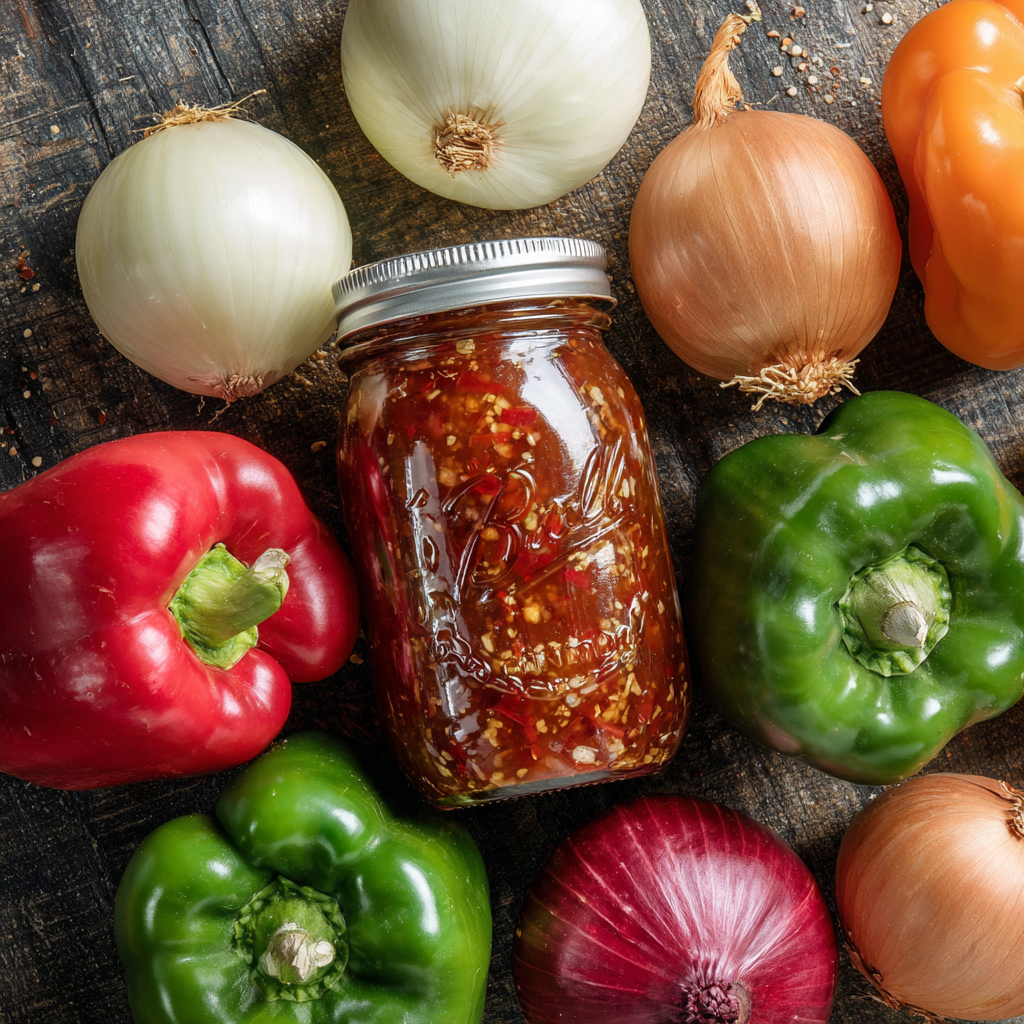
Exploring the Best Peppers for Relish Recipes
Choosing the right peppers is key to creating a flavorful, colorful, and balanced Pickled Pepper and Onion Relish Recipe. Peppers come in many varieties, and each brings something unique to your jar.
For the best pickled pepper and onion relish recipe, we recommend using:
| Pepper Type | Flavor Profile | Color Impact |
|---|---|---|
| Red Bell | Sweet, mild | Adds richness |
| Green Bell | Slightly bitter | Adds earthiness |
| Jalapeños or Hot Flakes | Spicy punch | Adds heat and zing |
Red and green bell peppers are a classic duo, giving both a sweet undertone and a garden-fresh bite. Want a spicier kick? Sprinkle in hot pepper flakes or swap in a few fresh jalapeños. Whether you’re aiming for a sweet pickled pepper and onion relish recipe or want to bring the fire, the balance is yours to control.
Don’t miss our comforting Doritos Cheesy Chicken Casserole—this relish pairs beautifully with cheesy bakes like it.
Why Sweet Onions Are Ideal for This Dish
Next up: onions. And not just any onions—sweet onions. Yellow or white onions work just fine, but sweeter varieties bring that mellow flavor that melts down perfectly in the syrup base. They reduce into soft, jammy morsels that cradle the pickled flavor without being overpowering.
If you’ve ever tried an old fashioned onion relish recipe, you’ve likely noticed that the onion-to-pepper ratio matters. In this version, it’s perfectly balanced. Sweet onions help tame the acidity from the vinegar and play beautifully with the sugar content, making each spoonful tangy, crisp, and deeply satisfying.
The Role of Vinegar, Sugar, and Heat Balance
A great pickled pepper and onion relish recipe for canning or fridge use is nothing without the right syrup base. Let’s break it down:
- White wine vinegar (1½ cups) – Brings that signature tang and pickling quality.
- White sugar (1½ cups) – Balances the acid with rich, sweet notes.
- Hot pepper flakes (1 tbsp, optional) – Optional, but highly recommended for heat lovers.
When combined and simmered, these ingredients reduce into a glossy, syrupy brine. This base penetrates the diced vegetables, ensuring every bite is sweet, tangy, and a little spicy.
Pro Tip: Make sure your vinegar is at least 5% acidity if you’re planning to water bath can this recipe. Safety first—especially for long-term storage!
Whether you want a pickled pepper and onion relish recipe for canning or for fresh use, mastering this trio (vinegar, sugar, heat) is what will take your homemade relish from good to unforgettable
Step-by-Step Instructions for the Perfect Relish
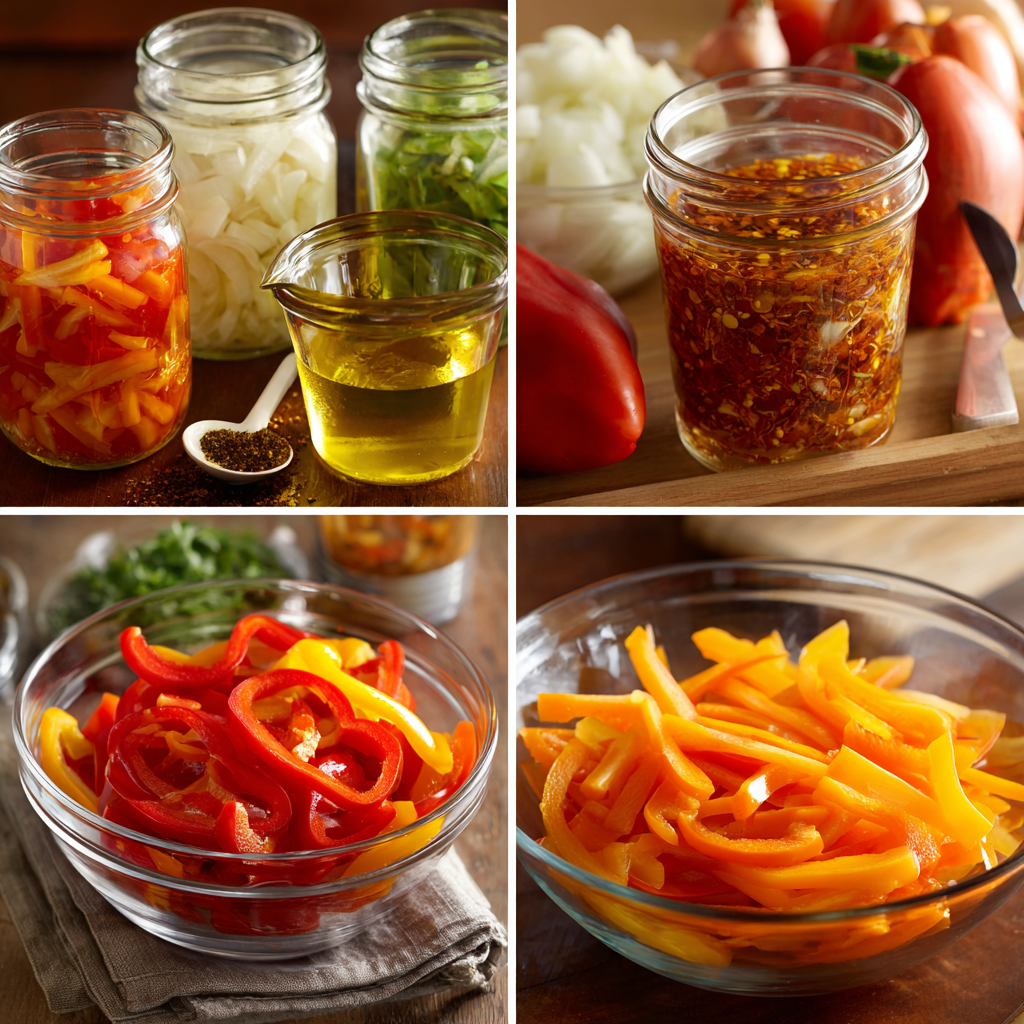
Prepping and Dicing Techniques for Uniform Texture
When making a pickled pepper and onion relish recipe, one detail often overlooked is the cut of your vegetables. Uniform dicing ensures everything cooks evenly and delivers a consistent texture in every bite. You’ll want to dice your red and green bell peppers and sweet onions into ¼-inch cubes—not too fine, not too chunky.
Here’s a simple trick:
First, slice the peppers vertically, remove the core and seeds, then flatten the pieces before dicing. Do the same with onions—peel, halve, then create even vertical and horizontal cuts. This helps you maintain consistency without sacrificing speed.
Remember, irregular cuts can result in uneven cooking. Smaller bits might turn mushy, while larger chunks stay undercooked. The goal? Soft, syrupy veggies that still have bite.
If you’re aiming for the best pickled pepper and onion relish recipe, don’t rush this step. Good prep = great texture.
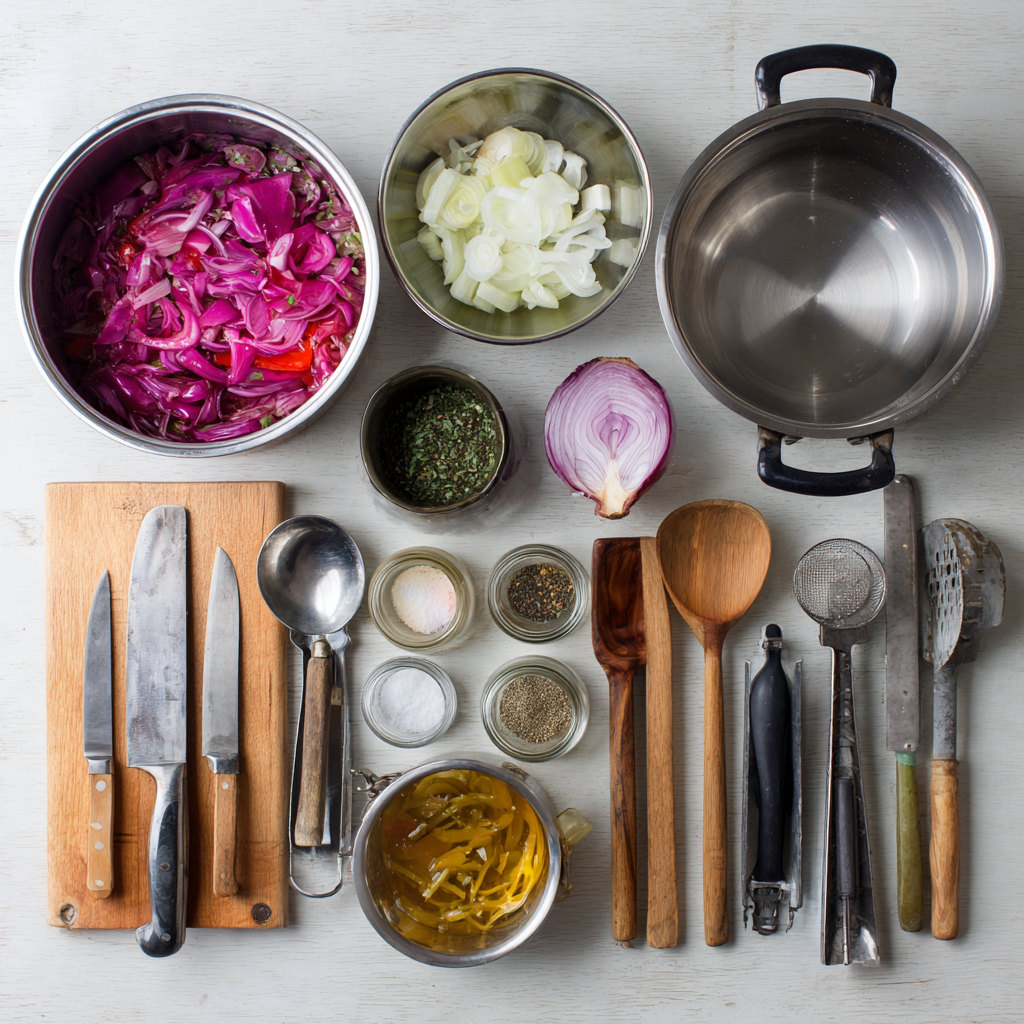
Cooking Down to the Right Syrupy Consistency
Now it’s time to bring the heat. If you’re using a Ninja Foodi, set it to high sear/sauté. If you’re cooking on the stove, go with medium-high heat.
Add your white wine vinegar and sugar to the pot and stir in hot pepper flakes if you’re adding heat. Bring the mixture to a rolling boil while stirring occasionally.
As the liquid boils, it begins to reduce and transform into a light syrup. You’ll notice the vinegar scent softening and the sugar thickening the mixture into a glossy base.
Next, toss in your diced peppers and onions. Stir gently to coat the veggies in the liquid.
Reduce the heat to medium-low and simmer uncovered for about 10 minutes. During this time, the vegetables will begin to soften and absorb all that sweet, tangy flavor.
You’ll know it’s done when:
- The syrup thickens slightly
- Peppers and onions are soft but still have body
- The aroma is mouthwatering
This process is the magic behind any easy sweet pepper relish recipe—you’re not just cooking veggies, you’re infusing them with flavor.
Want your relish thinner for hot dog toppings? Cook it 2–3 minutes less.
Craving a jammy texture for sandwiches? Let it go the full 10.
Check out our Italian Lemon Jam for another recipe that nails syrupy perfection in every spoonful.
Tips to Avoid Overcooking Your Vegetables
Cooking down relish is a game of patience, not overkill. Overcooking leads to soggy, flavorless veggies—and nobody wants that. Here’s how to avoid mistakes and nail the perfect pickled pepper and onion relish recipe every time:
- Use a wide pan for even heat distribution
- Don’t cover the pot—you want evaporation, not steaming
- Stir gently every 2–3 minutes to avoid breaking down the veggies
- Watch the syrup—it should coat the back of a spoon, not cling like glue
If your relish looks dry, add a splash of vinegar and stir. If it’s watery, give it another few minutes over low heat.
This balance of timing and temperature is what makes your relish stand out, whether you’re making a pickled pepper and onion relish recipe for canning or planning to eat it fresh this week.
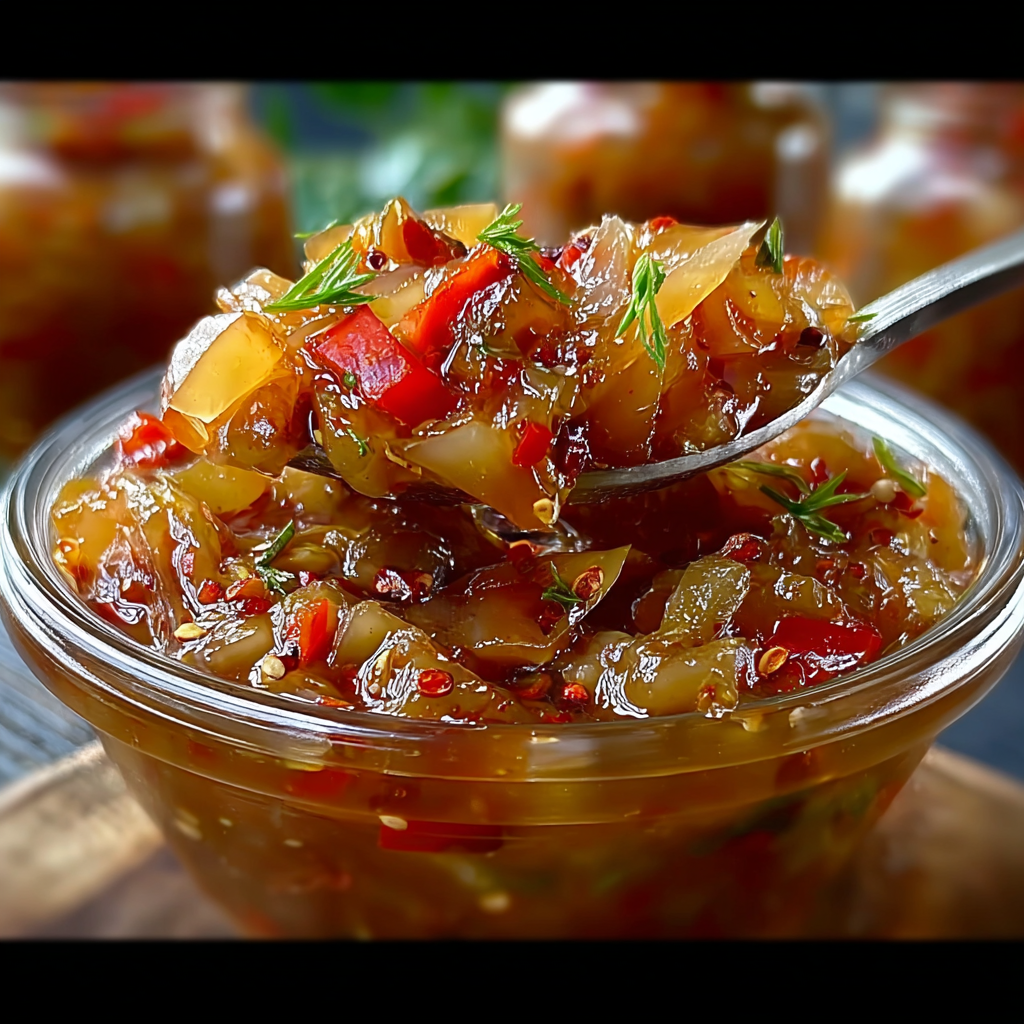
Easy Pickled Pepper and Onion Relish Recipe Variations
How to Make an Easy Sweet Pepper Relish
If you’re aiming for a sweet pickled pepper and onion relish recipe, reducing the heat and bumping up the sweetness can create a milder, family-friendly version perfect for sandwiches, wraps, and burgers.
Here’s how to do it:
- Omit hot pepper flakes entirely
- Use ¾ cup red bell pepper and ¾ cup yellow bell pepper for a richer sweet base
- Add 1–2 tablespoons of honey to the syrup during the final 3 minutes of simmering
This easy sweet pepper relish recipe is ideal for picky eaters or anyone who prefers gentle flavors with big personality. Plus, the natural sugar in bell peppers amplifies sweetness during cooking, giving the final product a jammy, almost fruity finish.
Want to really lean into sweet and savory? Try pairing this with a sharp cheddar or smoky gouda cheese spread. One taste and you’ll understand why folks call this the best pickled pepper and onion relish recipe for sandwiches.
Add-Ons: Garlic, Jalapeño, or Fresh Herbs?
Don’t be afraid to add flair to your pickled pepper and onion relish recipe. This isn’t a one-size-fits-all dish—it’s a blank canvas for flavor creativity.
Try these customizations:
| Ingredient | Flavor Impact | Suggested Amount |
|---|---|---|
| Fresh minced garlic | Deepens savory notes | 1 clove |
| Fresh jalapeño | Increases heat | 1 pepper, diced |
| Dried oregano | Adds Mediterranean twist | ½ tsp |
| Fresh dill | Elevates freshness | 1 tbsp, chopped |
Toss any of these into the mix once the syrup is hot but before you add the vegetables. Let them infuse as the mixture cooks, and they’ll create layers of flavor that make your relish unforgettable.
Pro Tip: Avoid overloading the pot with too many extras in your first batch. Start simple, taste test, and adjust on your next go.
If you’re canning for gifting, these subtle tweaks help you create a signature blend. Everyone loves a homemade touch, especially when it includes flavors they don’t find on grocery store shelves.
Looking for inspiration? Try our Italian Lemon Jam for another small-batch preserve with creative flavors.
Old-Fashioned Pickled Pepper and Onion Relish Recipe Twist
Craving that old fashioned pickled pepper and onion relish recipe flavor? Go vintage with these throwback upgrades:
- Replace white wine vinegar with apple cider vinegar
- Use brown sugar instead of white for a molasses kick
- Add mustard seeds or celery seeds for old-school pickle spice
These tweaks bring that rustic, farmhouse essence back to your relish—thicker, heartier, and deeply aromatic. It’s the perfect version for pairing with smoked meats, BBQ ribs, and charcuterie boards.
And if you’re wondering whether this version can be safely preserved, good news: this traditional-style pickled pepper and onion relish recipe for canning works just as well with the tweaks. Just be sure to follow standard food-safe canning procedures and confirm your vinegar maintains at least 5% acidity
How to Store, Preserve, and Extend the Life of Your Relish
Best Practices for Storing It Hot or Cold
Once you’ve simmered your Pickled Pepper and Onion Relish Recipe to sweet, tangy perfection, the next question is—how should you store it? The good news is that this recipe is super flexible. You can enjoy it fresh or stash it away for later.
For short-term use, simply ladle the hot relish into clean glass jars. Let it cool slightly, seal the jars tightly, and store them in the refrigerator. The relish will thicken as it cools and stay vibrant and flavorful for up to 3 weeks.
You can serve it cold or reheat it slightly depending on how you want to use it. Cold relish is perfect for sandwiches and wraps, while warm relish tastes amazing over grilled meats.
Pro tip: Let your relish chill overnight before the first taste. That short wait lets all the flavors settle, mingle, and intensify beautifully.
Check out our Juicy Air Fryer Hamburgers to see how this relish can transform even a basic burger into something unforgettable.
Thinking Long-Term? Canning Is the Way to Go
If you’ve made a big batch or want to stock your pantry, canning your Pickled Pepper and Onion Relish Recipe is a great idea. It’s safe, simple, and makes those beautiful jars shelf-stable for months.
Yes—you can water bath can this recipe, and it’s actually a popular choice for preserving homemade relishes. Just be sure you’re using a vinegar with at least 5% acidity. Most white wine and apple cider vinegars qualify, but double-check your bottle just to be safe.
Here’s how to do it:
- Boil jars and lids to sterilize
- Fill jars with hot relish, leaving ½ inch at the top
- Wipe the rims, seal with lids, and screw on bands
- Place jars in a boiling water bath and process for 15 minutes
- Let the jars cool for 12–24 hours. Listen for the “pop” that signals a secure seal
Once sealed, these jars can last for up to a year in a cool, dark pantry—ready to grab whenever you need a tangy, punchy condiment.
This method is also great if you’re gifting relish to friends and family. It’s the kind of personal touch that turns a simple jar into something special.
Want to tweak the flavor before canning? Make a small test batch first. Once it’s sealed, there’s no going back.
Storage Comparison: Which Method Fits Your Lifestyle?
If you’re unsure which route to take—fridge, pantry, or freezer—here’s a breakdown to help you decide:
| Storage Method | How Long It Lasts | Best For |
|---|---|---|
| Refrigerator | 2 to 3 weeks | Quick meals, daily use |
| Water bath canning | Up to 12 months | Long-term use, holiday gifts, meal prep |
| Freezer-safe jars | 3 to 4 months | Emergency stash, preserving extra batches |
Whether you’re making a modern twist or reviving an old fashioned pickled pepper and onion relish recipe, preserving it the right way ensures you never waste a drop.
Even an easy sweet pepper relish recipe becomes pantry gold when it’s safely canned and ready to enjoy all year long.
Creative Ways to Use Pepper and Onion Relish
What Is Pickled Pepper and Onion Relish Used For?
A common question we hear all the time is: “What is pepper and onion relish used for?” The answer? Almost everything. This bold, tangy, slightly sweet condiment can elevate dishes across all kinds of cuisines. It’s not just a sidekick—it’s a star.
Whether you’re reaching for a spoonful straight from the jar or adding a layer to your favorite meal, this relish adds instant flavor and a gourmet feel.
Here’s where it truly shines:
- Spread on burgers, sandwiches, and wraps
- Served alongside grilled meats like pork chops, sausage, or chicken
- Tucked into charcuterie boards with cheeses and crackers
- Swirled into pasta salads or grain bowls for a tangy pop
- Mixed with cream cheese for a quick party dip
- Spooned onto scrambled eggs or breakfast burritos
- Layered under melted cheese on bruschetta or crostini
If you’re still wondering how to serve it, just ask: “Would this dish taste better with a pop of sweet heat?” If the answer’s yes—you know what to do.
Toppings, Sandwich Spreads, and Grilled Pairings
One of the simplest and most satisfying ways to use this Pickled Pepper and Onion Relish Recipe is as a sandwich spread. The combination of vinegar, sugar, and softened vegetables gives it a jam-like texture that clings perfectly to bread, toast, or wraps without making them soggy.
Try it on:
- Roast beef sandwiches
- Turkey melts with sharp cheddar
- Grilled veggie paninis
- Tuna or egg salad wraps
- Fried chicken sliders
For grilled meats, it’s even better. Imagine a juicy brat or hot link loaded with relish—that’s how summer should taste. The relish cuts through the fat of grilled proteins, adding a zippy balance that keeps bites exciting.
You can even stir a few spoonfuls into pan sauces to deglaze a skillet or create a sweet-spicy glaze for pork or chicken. Just add a splash of broth and simmer it down—it’s that versatile.
Creative Culinary Uses You Haven’t Tried Yet
Let’s go beyond the obvious. Once you’ve got a jar of this relish in your fridge, the possibilities really open up. Here are some outside-the-box ways to use this easy pickled pepper and onion relish recipe like a pro:
- Mix into meatloaf or burger patties for added moisture and sweet-savory depth
- Stir into deviled egg filling for an unexpected tang
- Use as a base for BBQ sauce—combine with ketchup and mustard for a shortcut version
- Top baked potatoes or sweet potatoes for a sweet-heat contrast
- Toss into cold pasta or macaroni salad instead of pickles
- Add to grilled cheese sandwiches for next-level flavor
- Drizzle over tacos or nachos for a colorful, zingy garnish
There’s no wrong way to use it—and chances are, once you start, you’ll find yourself reaching for it way more than you expected.
Doubling the Batch and Gifting Your Homemade Relish
Can I Double the Recipe? Here’s How to Do It Right
One of the top questions readers ask is, “Can I double the recipe without ruining it?” The answer is yes—you can absolutely double this Pickled Pepper and Onion Relish Recipe, and it’s a great idea if you’re feeding a crowd or want extra jars for later.
That said, doubling any relish recipe isn’t just about tossing more ingredients in a pot. A little attention to detail makes all the difference between a perfectly preserved relish and a soggy, unbalanced mess.
Here’s how to scale successfully:
- Maintain ratios exactly—if you add double the peppers, onions, and sugar, don’t forget to also double the vinegar.
- Choose the right pot: Use a large, wide saucepan or stockpot to give the mixture room to cook down evenly.
- Allow for extra time: A bigger batch takes longer to simmer. Be patient and keep a close eye on the texture—it should still end up thick and syrupy.
- Stir more frequently: More volume means a higher chance of scorching, especially as sugar reduces. Keep things moving gently.
One thing you should never do when scaling? Reduce the vinegar. The acidity is key not only for taste but for safety, especially if you’re preserving your pickled pepper and onion relish recipe for canning.
For the best results, taste-test a small portion before canning or storing. A quick flavor check goes a long way in avoiding regrets.
Turning Jars Into Gifts With Homemade Charm
Looking for a way to share your love of flavor? Homemade relish makes a memorable, delicious gift—especially when it’s packaged thoughtfully.
Here’s how to present your relish with style:
- Use mason jars or small jam jars for the perfect gift size
- Print simple labels that include the name, date, and storage tips
- Tie raffia, string, or ribbon around the lid with a handwritten tag
- Include a suggestion card with serving ideas: “Perfect on grilled sausages!”
Even a basic easy sweet pepper relish recipe feels elevated when it’s handed to someone as a handcrafted gift. It shows you care—and they’ll definitely taste the love in every bite.
For seasonal gifts, consider pairing your relish with artisan bread, gourmet crackers, or even a bottle of local wine. It’s an effortless way to build a unique edible gift set.
Hosting a dinner party soon? Send guests home with a jar of relish as a flavorful parting gift.
Making It a Group Effort: Canning Day at Home
If you’ve got friends or family who love to cook, why not plan a relish-making day together? Pick a weekend, stock up on ingredients, and make a day of it. Set up a few cooking stations—chopping, simmering, canning—and let everyone create their own spin on the pickled pepper and onion relish recipe.
Not only is it productive, it’s fun. You’ll laugh, cook, and leave with a fridge or pantry full of flavorful jars. You might even make it a new seasonal tradition.
Plus, working in larger batches makes it easier to split the cost of ingredients and use up extra produce from your garden or farmer’s market hauls.
Real FAQs, Kitchen Fixes, and Expert Tips
Avoid These Common Mistakes When Making Relish
Even the most straightforward recipes have their pitfalls—and this Pickled Pepper and Onion Relish Recipe is no exception. Luckily, most issues are easy to fix if you know what to watch for.
Overcooking the Vegetables
Relish should have texture, not turn into a soggy blend. If you simmer too long, your peppers and onions lose their structure. Ten minutes is often plenty—keep your eye on the pot.
Skipping the Syrup Stage
One of the most important steps is reducing the vinegar and sugar into a light syrup. If you rush through it, your relish may turn out watery instead of sticky and spoonable.
Changing the Vinegar-Sugar Ratio
Tempted to tweak the amount of vinegar or sugar? Be careful. The balance of acid and sweetness isn’t just about taste—it’s key to preserving safely, especially if you plan to can your relish.
Chopping Unevenly
A mix of large and tiny pieces results in uneven cooking. Uniform ¼-inch dices give you even texture and better flavor distribution.
If It Tastes Too Sweet or Too Sharp—Here’s the Fix
Sometimes, after you taste your finished batch, the flavor might be off-balance. Don’t worry—it’s totally fixable as long as you haven’t sealed your jars yet.
If the relish is too sweet:
Stir in a splash of vinegar—apple cider or white wine vinegar works. Let it simmer another 5 minutes to mellow everything out.
If it’s too sour or sharp:
Add a spoonful of sugar or honey while the mixture is still warm. Stir well and taste after a few minutes. It’ll smooth out without losing that bright pickled flavor.
Tip: Always cool a spoonful first before judging the flavor. Hot relish can taste different than cold relish.
What Kind of Peppers Work Best in Relish?
One of the most frequent questions we get is: “What pepper should I use in onion and pepper relish?” The answer? It depends on what you’re after.
Here’s a quick cheat sheet:
| Pepper Type | Taste Profile | Ideal For |
|---|---|---|
| Red Bell Peppers | Sweet and juicy | Classic, mild flavor |
| Green Bell Peppers | Earthy, slightly bitter | More savory depth |
| Yellow/Orange Bells | Very sweet and mellow | Sweeter versions of the recipe |
| Jalapeños | Spicy with a green bite | Adds noticeable heat |
For a traditional, balanced pickled pepper and onion relish recipe, stick with red and green bell peppers. Want to turn up the sweetness? Add some yellow or orange peppers. Need more fire? Toss in a diced jalapeño or a few red pepper flakes.
This level of versatility is what makes this relish recipe so popular. You can personalize every batch depending on the season, your pantry, or your tastebuds.
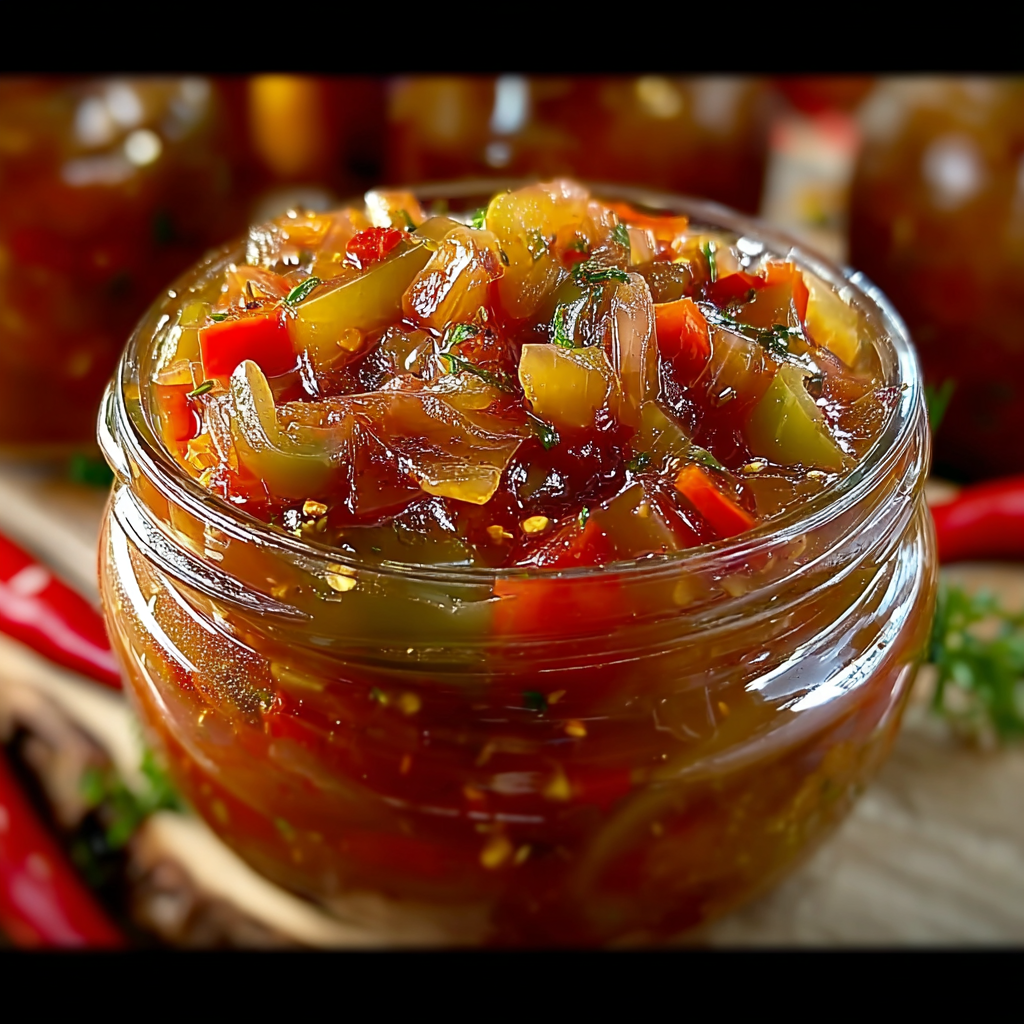
Similar Recipes People Search For—and Why This One Rises Above
Sweet Pickled Pepper and Onion Relish Recipe: What Makes It So Popular?
If you’re exploring recipes, you’ve likely come across the term sweet pickled pepper and onion relish recipe again and again. Why? Because it delivers the perfect balance of sugar and vinegar, making it a favorite for everything from burgers to cheese platters.
What sets this particular version apart is its adaptability. It’s sweet, yes—but not cloying. The sugar enhances the natural sweetness of bell peppers, while the vinegar cuts through with just enough bite. Additions like honey or maple syrup are optional, not required, which keeps the base recipe simple.
For those who enjoy a bolder flavor, adding a hint of heat or some herbs like thyme or oregano can personalize it without complicating the process. It’s easy to see why this remains one of the most searched versions of pickled relish online.
Throwback Flavor: The Old Fashioned Pickled Pepper and Onion Relish Recipe
There’s something comforting about an old fashioned pickled pepper and onion relish recipe—a nod to farmhouse kitchens and passed-down recipes scrawled on recipe cards.
This version embraces the vintage feel with modern clarity. You get the same slow-simmered flavors, the same simplicity, and the same reliable results—without the guesswork. No obscure ingredients or confusing steps. Just time-tested flavor, made simple.
You can even replicate the “old-time” profile by swapping in apple cider vinegar, brown sugar, or celery seed—classic ingredients often found in heritage recipes.
Easy Pickled Pepper and Onion Relish Recipe: Perfect for Beginners
A major search trend is for an easy pickled pepper and onion relish recipe—and that’s exactly what this delivers. Whether it’s your first time making relish or your fiftieth, the process is approachable and stress-free.
Everything boils down to:
- 6 core ingredients
- One pot
- Less than 30 minutes of actual cooking
- Optional tweaks for flavor and texture
There’s no complicated prep, no long wait times, and no specialized tools required. And yet the results are bright, bold, and ready to impress at dinner, cookouts, or holiday spreads.
Best Pickled Pepper and Onion Relish Recipe: What Sets It Apart?
With so many versions floating around online, what qualifies this one as the best pickled pepper and onion relish recipe? It comes down to three things:
- Balanced taste: You’re not overwhelmed by sweetness or acid—both are perfectly matched.
- Versatile use: It pairs with everything from grilled meats to cheese boards to grain bowls.
- Built for real life: You can scale it up or down, can it, freeze it, or eat it fresh. It doesn’t demand perfection—it rewards creativity.
It’s a small-batch staple that behaves like a gourmet condiment. And when made with quality ingredients, it beats store-bought versions every single time.
Pickled Pepper and Onion Relish Recipe for Canning: Safe, Simple, and Satisfying
Preserving your work is half the fun—and this is hands-down one of the easiest ways to start. If you’re specifically hunting for a pickled pepper and onion relish recipe for canning, this version is safe and proven.
Using a vinegar with 5% acidity ensures that your batch meets home canning safety standards. The sugar helps stabilize the pH and extend shelf life. When processed properly in a water bath, your jars will be sealed and pantry-ready for up to a year.
It’s an ideal project for home cooks who want to stock their shelves with handmade condiments—or gift them to friends and family.
This Pickled Pepper and Onion Relish Recipe Deserves a Spot in Every Kitchen
If you’ve been looking for a Pickled Pepper and Onion Relish Recipe that’s easy to follow, endlessly versatile, and packed with homemade flavor—this is it. From small batches made fresh for sandwiches, to large batches jarred for gifting, this recipe covers it all.
What sets it apart is its:
- Balanced taste (sweet, tangy, and customizable)
- Simplicity (just a few ingredients and steps)
- Flexibility (hot or mild, canned or fresh, used hot or cold)
Whether you’re after an old fashioned pickled pepper and onion relish recipe, a sweet pickled pepper and onion relish recipe, or something unique for your pantry, this version is your go-to. Serve it, share it, store it—it’s up to you.Tray this : Ground Beef Stir Fry
What pepper should I use in onion and pepper relish?
You have options! The beauty of this pickled pepper and onion relish recipe is that you can personalize the flavor depending on the peppers you choose:
Pepper Type
Flavor Outcome
Red bell peppers
Sweet and classic
Green bell peppers
Earthy, slightly bitter
Yellow/orange bells
Milder and fruity
Jalapeños or chilies
Adds a spicy kick
For the best balance of sweet and tangy, a mix of red and green bell peppers works beautifully. Want to turn up the heat? Add a chopped jalapeño or red pepper flakes.
Can I water bath can this recipe?
Definitely! This relish is designed to be safe for water bath canning, provided you stick to vinegars with at least 5% acidity—like white wine vinegar or apple cider vinegar.
Here’s a quick canning refresher:
Sterilize your jars and lids
Fill hot jars with hot relish, leaving ½-inch headspace
Seal and process in a boiling water bath for 15 minutes
Let jars sit undisturbed for 24 hours to finish sealing
Once sealed, they’ll keep on your shelf for up to 12 months—making this not only a flavorful condiment but a practical pantry staple.
Can I double the recipe?
Yes, you can absolutely double this pickled pepper and onion relish recipe—and it’s an excellent idea if you’re planning to preserve jars for later or give them away as gifts. Just make sure you double all the ingredients equally, especially the vinegar, sugar, and vegetables, to maintain the correct flavor and acidity balance.
If you’re canning the relish, it’s crucial that you don’t reduce the vinegar or increase sugar too much, since both affect the pH and shelf safety.
Tip: Use a wide-bottomed pot when making a large batch so the syrup reduces evenly and the vegetables cook uniformly.

